Cambodian cuisine offers travelers a variety of unique taste experiences. Highlights include Amok (fish, meat, or vegetables steamed in coconut milk and spices), Lok Lak (fried beef in a spicy marinade), and Kuy Teav (a noodle soup with meat and rice noodles). The use of Prahok, a fermented fish paste, characterizes many dishes. Adventurous eaters can try the Durian fruit, though its smell can be off-putting. Street markets offer a wide variety of street food and exotic fruits, as well as desserts like sticky rice. Overall, Cambodian cuisine is fresh, spicy, and full of diverse flavors, not as spicy as neighboring Thailand, and definitely a delight for your trip to Cambodia
Cambodian or Khmer cuisine?
According to Wikipedia, Cambodian and Khmer cuisine are quite different from each other. While Cambodian cuisine is a generic term for all ethnic groups in the kingdom, Khmer cuisine refers specifically to the almost two-thousand-year-old Khmer culinary tradition.
In combination with elements and influences from Indian, Chinese, Portuguese and, more recently, French cuisine, a cooking tradition has developed over the centuries which, on the one hand, has similarities with neighboring countries and, on the other hand, stands out for its uniqueness.
Popular pages: Discover Cambodia
Popular dishes in Cambodia
- Amok: Traditional dish with fish or chicken, steamed in a rich coconut curry sauce.
- Lok Lak: Spicy beef served with a delicious pepper sauce. Lok Lak is great for cooking at home.
- Nom Banh Chok: Rice noodles with a mild, delicate coconut curry sauce, often served with fresh vegetables.
- Kuy Teav: Rice noodle soup with various types of meat or seafood, preferably for breakfast.
- Bai Sach Chrouk: Fried pork with rice and cucumber salad.
- Chicken curry: As the name suggests, this is chicken with a tasty curry.
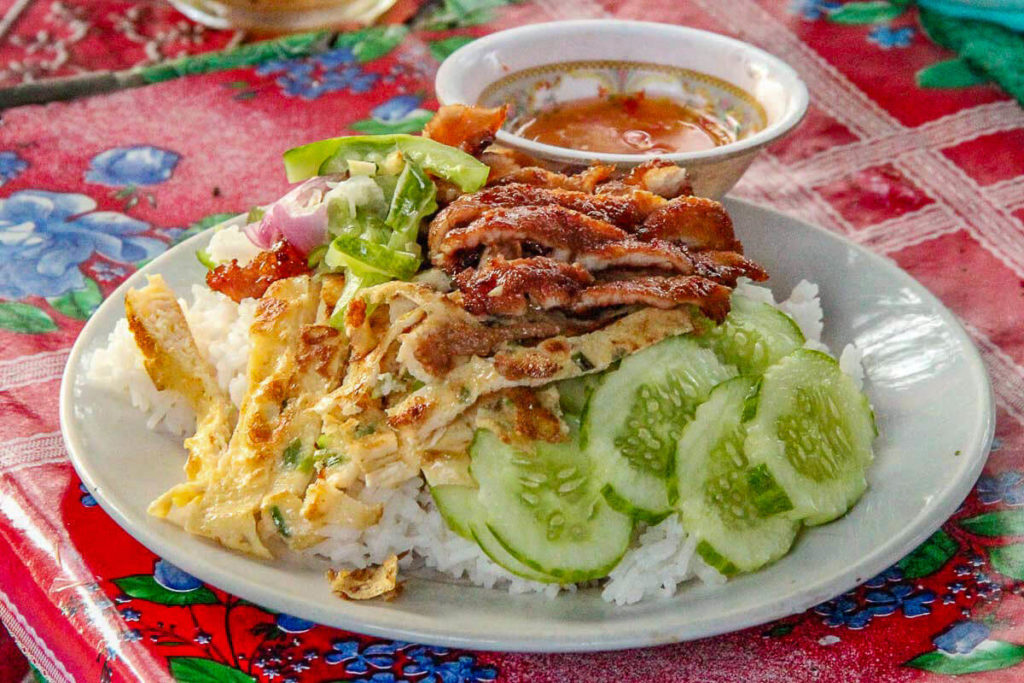
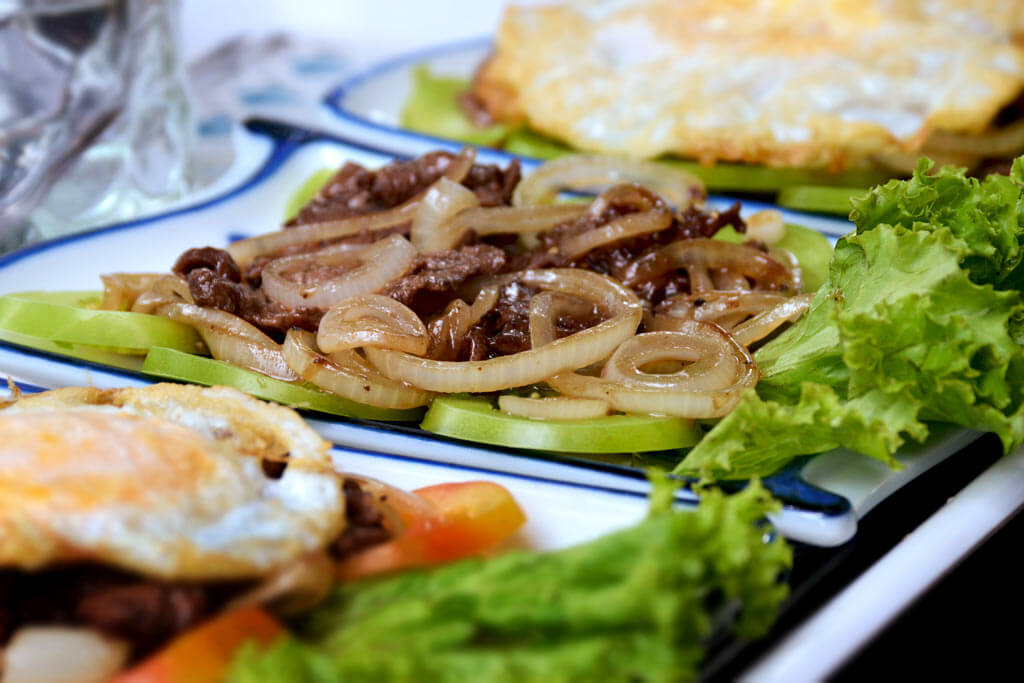
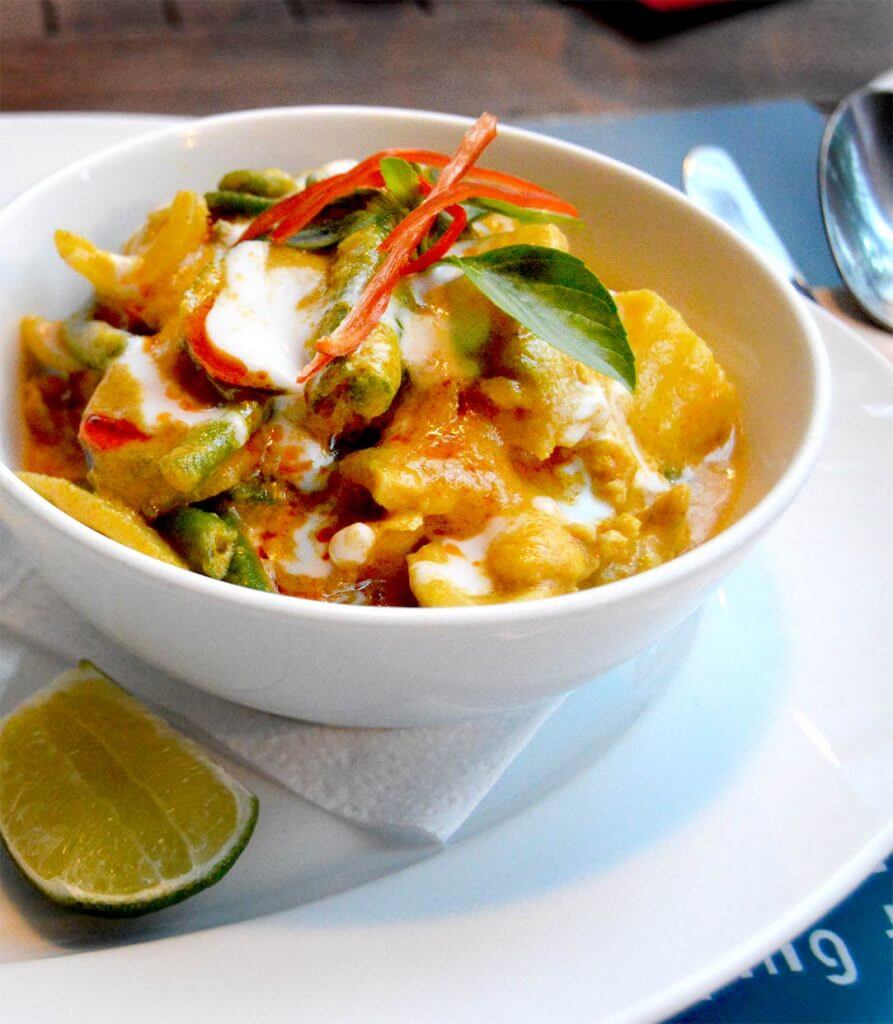
Geographical features
While seafood and saltwater fish dominate the menus in the southern provinces of Cambodia, in the north it is mainly curries with lots of coconut milk. Unfortunately, wild animals of all kinds are also on the menu. A circumstance that is not exactly beneficial for the population. For a few years now, the famous Kampot pepper from the region of the same name has been making its way back into many pots and pans around the world, not just in Cambodia. And not just in white, green or black, but also in red.
The real red pepper can only be found in Kampot. And only pepper from this region can bear the name genuine red pepper, as Kampot pepper is a protected designation of origin. The province of Kratie also has a very special feature: Pomelos. The island of Koh Trong in particular is said to grow the tastiest of its kind in the whole of Cambodia.
Rice is known to be one of the main staple foods in Cambodia. It is grown all over the country, the white gold. The western province of Battambang is considered to be the country’s rice chamber. The Phka Rumduol jasmine rice variety grows and thrives there. In 2022, it was named the best rice variety in the world for the fifth time at the Rice Trader World Conference in Phuket.
The best palm sugar comes from Kampong Speu, which, like Kampot pepper, has a protected geographical indication. Cardamom comes from the mountain range of the same name, which stretches across the province of Koh Kong on the Cambodian side.
Seasoning pastes for an aromatic kick
Kroeung (គ្រឿង) forms the basis of many dishes in Cambodian cuisine. The eight most commonly used ingredients are lemongrass, lime peel and leaves, galangal, turmeric, garlic, shallots, dried red chilies and various rhizomes such as galangal and fingerroot, each in different combinations. It is usually red, green or yellow. Depending on the dish, the kroeung needs to have a very specific flavor. For example, samlar kakou, in which lime leaves are used instead of turmeric for fish amok. Even today, many Cambodians still use a mortar to grind ingredients freshly harvested at the market or in their own garden. Those with less time and leisure buy ready-made kroeung at the market.
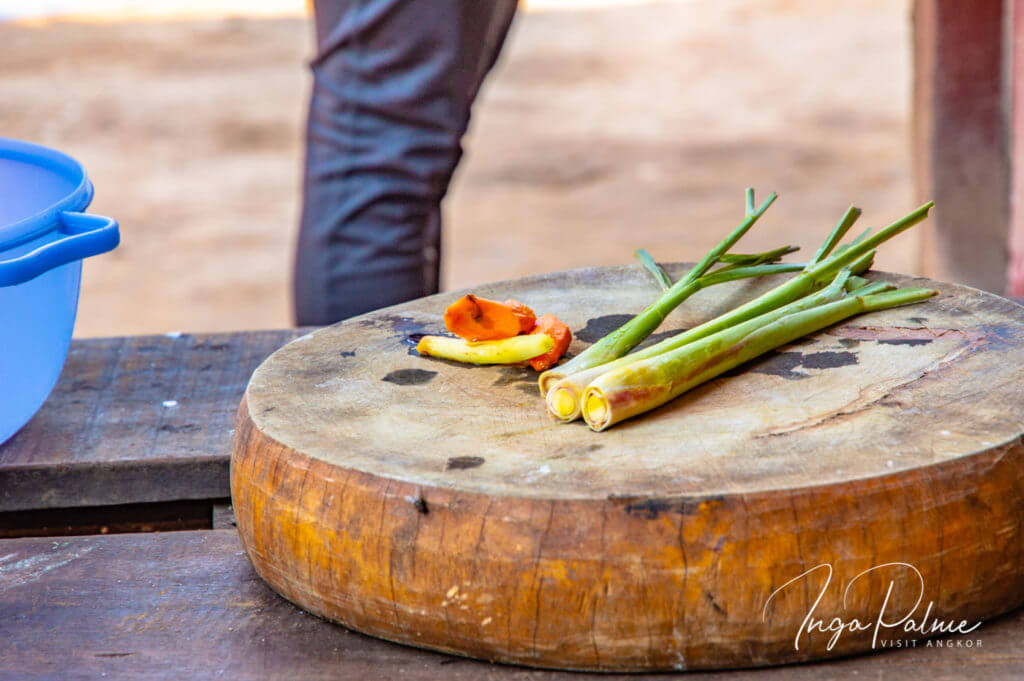
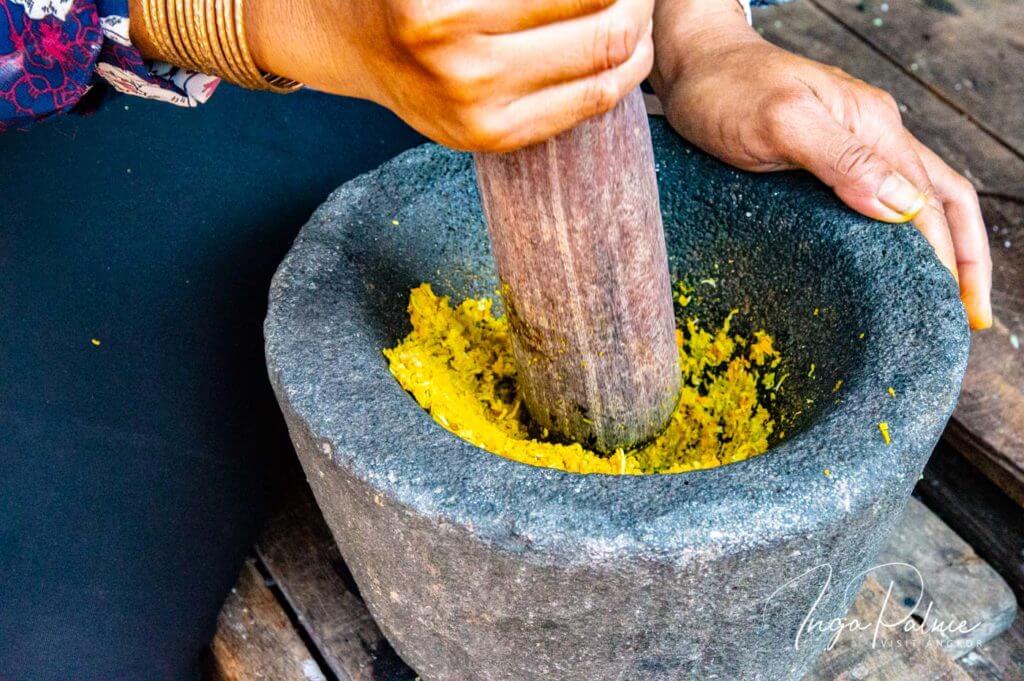
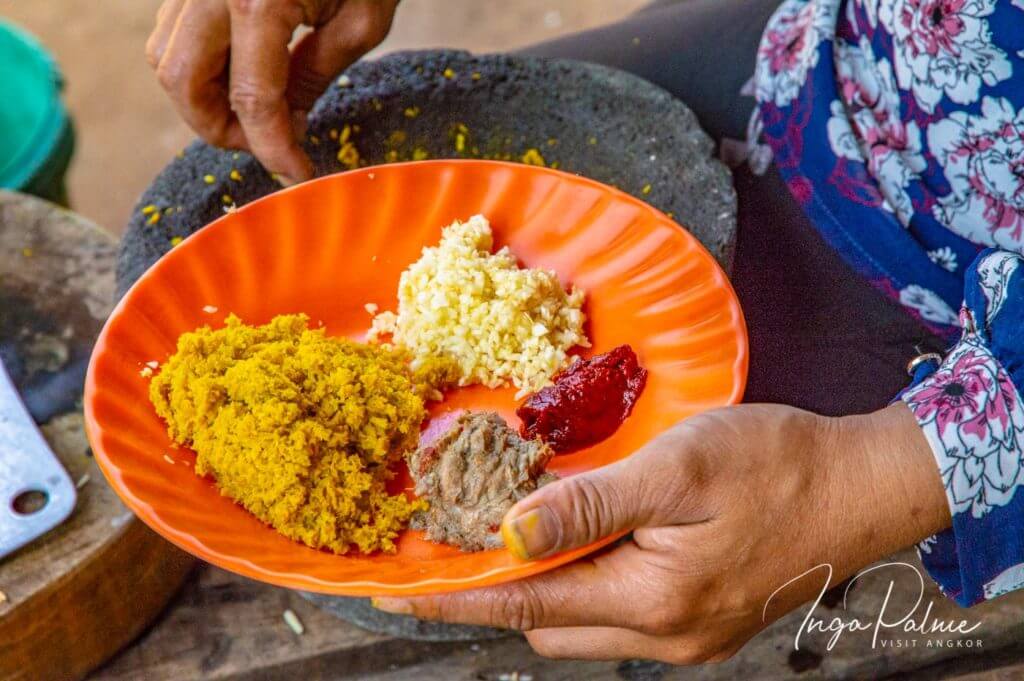
Prahok (ប្រហុក) is a salted and fermented fish paste that is used as a condiment or side dish in Cambodian cuisine. Originally, prahok was intended to preserve fish during the months when fresh fish was not available. The strong smell, similar to Limburg cheese, earned prahok the nickname “Cambodian cheese”. The Khmer people love their prahok and so the Cambodian saying “no prahok, no salt” is no coincidence, as it underlines its essential importance in Cambodian cuisine.
As a spice, prahok is part of almost every Khmer dish, often mixed with rice or even served as a dip. There are various fermentation methods to produce it, and the process can take anywhere from 20 days to three years. If you want to get an impression, you must visit the fish factory in Battambang. But be careful: the sight and smell might upset some people’s stomachs.
Cooking Classes & Food tours
To get to know Cambodian cuisine better, it is definitely worth attending a cooking course. Here you will learn about the individual ingredients and the preparation of Cambodian cuisine under professional guidance. Depending on what is on offer, you can go shopping at the market beforehand. Prices from approx. 25 dollars. If cooking yourself is not your thing, food tours are a great alternative – here is a small selection for Siem Reap:
- Paper Tiger Cooking Class: The popular veteran in its class. Since 1999, everything here has revolved around authentic Cambodian cuisine.
- Beyond Unique Escapes: An organization founded by Australians. They also have a vegan cooking class in their program.
- Siem Reap Food Tours: For $75 you can travel across country through the flavors of Cambodian cuisine. Founded by Steven Halcrow and Lina Goldberg, the tour has been mentioned in the New York Times and Vogue, among others. Further information and booking on the website.
- Shinta Mani: Chef Chanrith does the honors here to introduce you to Cambodian cuisine. However, the prerequisite is that you are a hotel guest.
- Countryside Cooking Class: Just outside on the main road to Siem Reap’s old airport with a wide selection on offer.
- Dine with the locals: A somewhat different and special cooking class. Here you stay with a family and cook together with them.
Desserts in Khmer cuisine
The traditional Khmer dessert krob knor (គ្រាប់ខ្នុរ) made from jackfruit seeds is a direct descendant of the Portuguese fios de ovos. The bright green color of Num Chak Kachan នំច័ក្កច័ន is provided by pandan leaves ground in a meat grinder. With the right amount and a lot of patience, the typical white-green layers of rice cake are created. Speaking of rice: it often serves as the basis for desserts. These include nom kor and nom ply eye, the Cambodian rice balls. Puddings made from coconut milk or cream and fruit desserts such as bey dom neib are also popular.
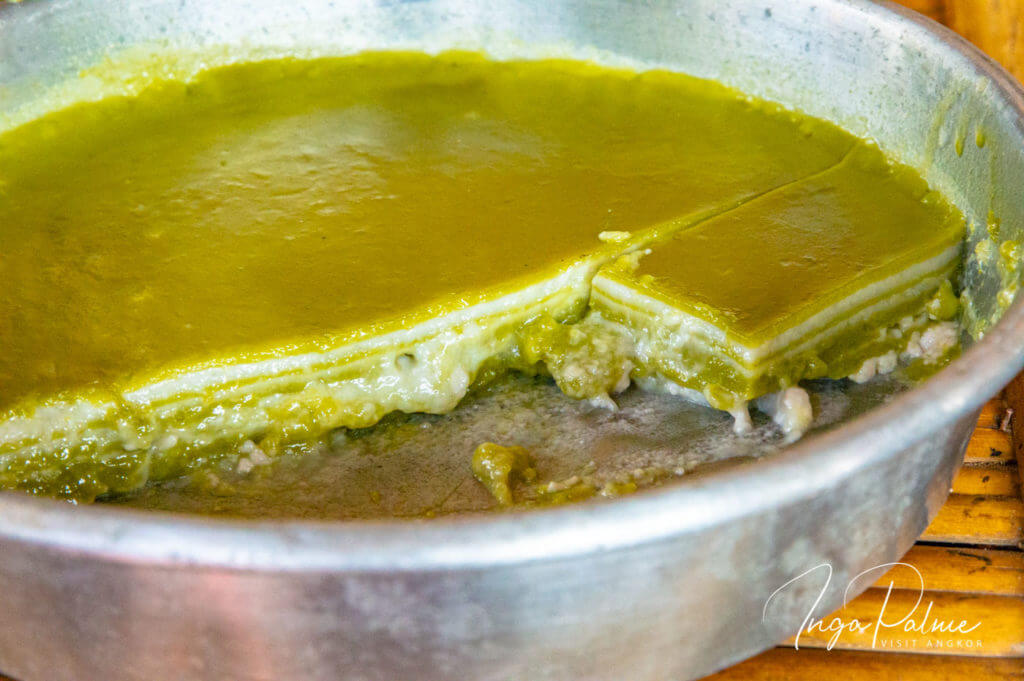
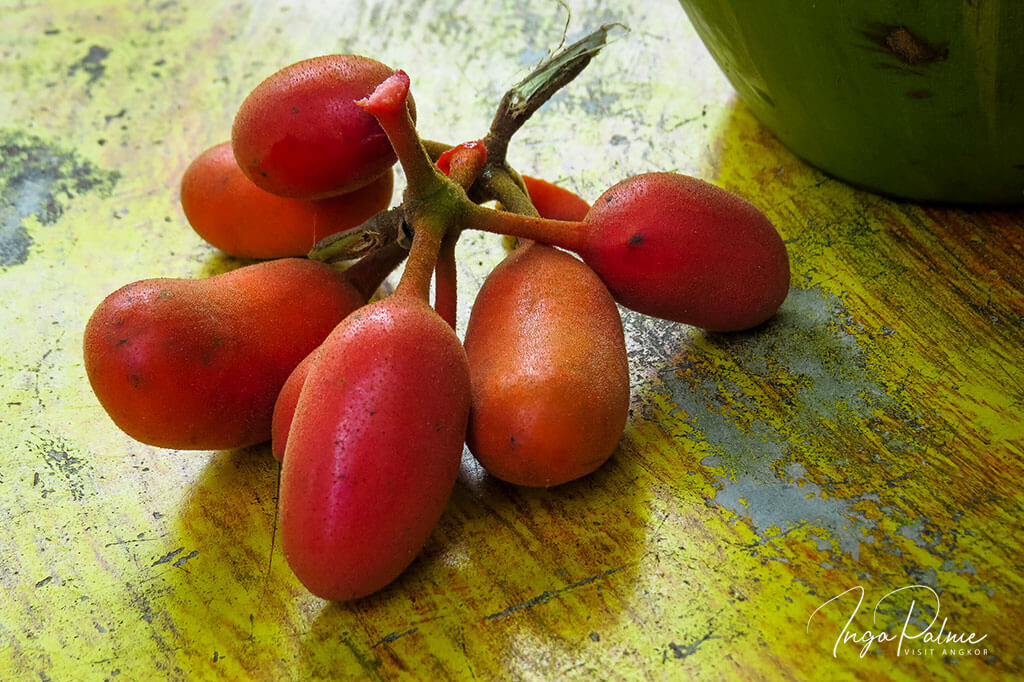
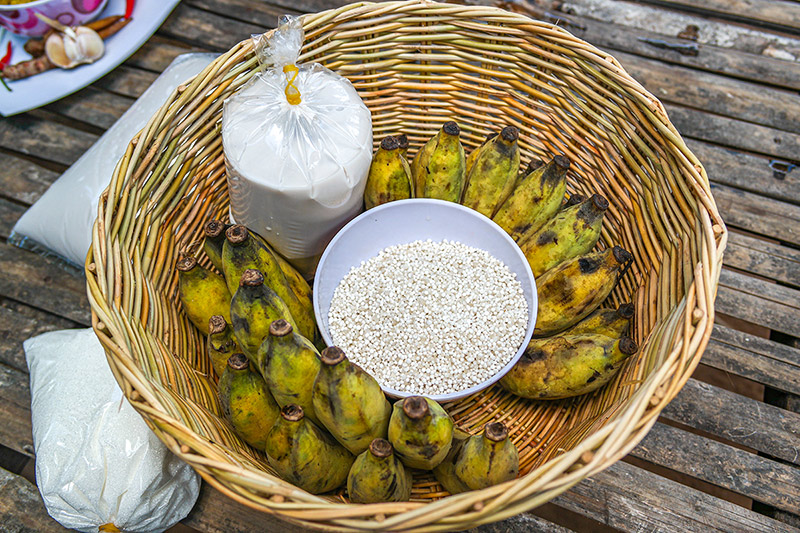
By the way: It is customary in Cambodia for all dishes on a menu to be served and eaten at once, except for dessert. Smacking quietly is, so to speak, good manners. Singing while eating, on the other hand, is not appreciated.
The history of Khmer cuisine
Indian merchants brought spices into the country as early as the 2nd century. The Khmer refined the imported curry pastes with lemongrass and galangal. As a result of the growing Khmer empire in the 9th to 15th centuries, Khmer cuisine contributed significantly to the spread of Indian influence in large parts of South-East Asia. The close contact between the Khmer Empire and the Kingdom of Ayutthaya is said to have resulted in a particular similarity to Thai cuisine, although Cambodian dishes contain less sugar and chili.
Portuguese traders brought new types of fruit and vegetables to Cambodia at the beginning of the 16th century. These included tomatoes, pineapples, papayas, peanuts, cashews and others. In the 17th and 18th centuries, Vietnamese cuisine influenced Khmer cuisine due to their rule in Cambodia. It is still not entirely clear whether Cambodian lok lak originated from Vietnamese cuisine.
During their occupation from 1863 to 1953, the French provided the Cambodians with culinary elements, above all the baguette, which is still available everywhere in the country today. The same goes for potatoes, onions, butter, margarine and carrots. Not forgetting coffee, chocolate, beer and even wine. The precursors of the latter are mentioned as early as the 14th century in the form of fermented drinks. You can read about it in the brochure “Customs in Cambodia” by Chaou Ta-kuan.
The influence of France is also reflected in the Cambodian language. Terms such as coffee កាហ្វេ have been adopted. Or the French “Beurre” for butter simply “Beu” ប៊ឺ. With the Num Pang Barang sandwich, there is even a name for the French. “Barang” means “foreigner”.
After the Second World War, it was “in” among Cambodia’s middle and elite classes to employ chefs who had been trained in French cuisine. With the Khmer Rouge’s reign of terror in the 70s and 80s, this knowledge was almost completely destroyed throughout the country. To avoid starvation, the population subsisted on simple rice porridge, frogs, snakes and insects, especially spiders.
Nowadays, insects of all kinds are considered a tourist attraction, especially in cities such as Siem Reap and Phnom Penh.
Cambodian cuisine worldwide
In recent years, Cambodian cuisine has been increasingly making a name for itself. Just recently, in October 2023, the book “Saoy, Royal Cambodian Home Cuisine” by Chef Nak was crowned “The Best Cookbook In The World” in the “Best of the Best Books” category at the Gourmand Worlds Awards. In 2022, the culinary travel guide “The Culinary Art of Cambodia” received the special prize from the Gourmands Worlds jury. “The Taste of Angkor” received the award for best Asian cookbook in 2021
Nevertheless, Cambodian cuisine is more or less unknown abroad compared to Thai and Vietnamese cuisine. Occasionally, international media pick up on the trend and report on the new self-confidence of the Cambodian masters of cuisine.
Cuisine Wat Damnak was the first restaurant to make it onto the list of “Asia’s 50 Best Restaurants” in 2015. In 2021, Nesat Seafood House in Phnom Penh, Lum Orng Farm to Table and The Sugar Palm in Siem Reap were three winners under the title “Essence of Asia” from The World’s 50 Best.
Cambodian hit list of drinks
Water and beer are at the top of the list. Water, because you simply can’t do without it in the heat, and beer, because it not only tastes good, but also, depending on the variety (e.g. Cambodia) and sales-boosting, you can often win another one.
Also popular is the juice made from pressed sugar cane, often sold in cones at markets with crushed ice. Here and there you can still see an older model of machine. Coffee is available black, with condensed milk, hot or cold.
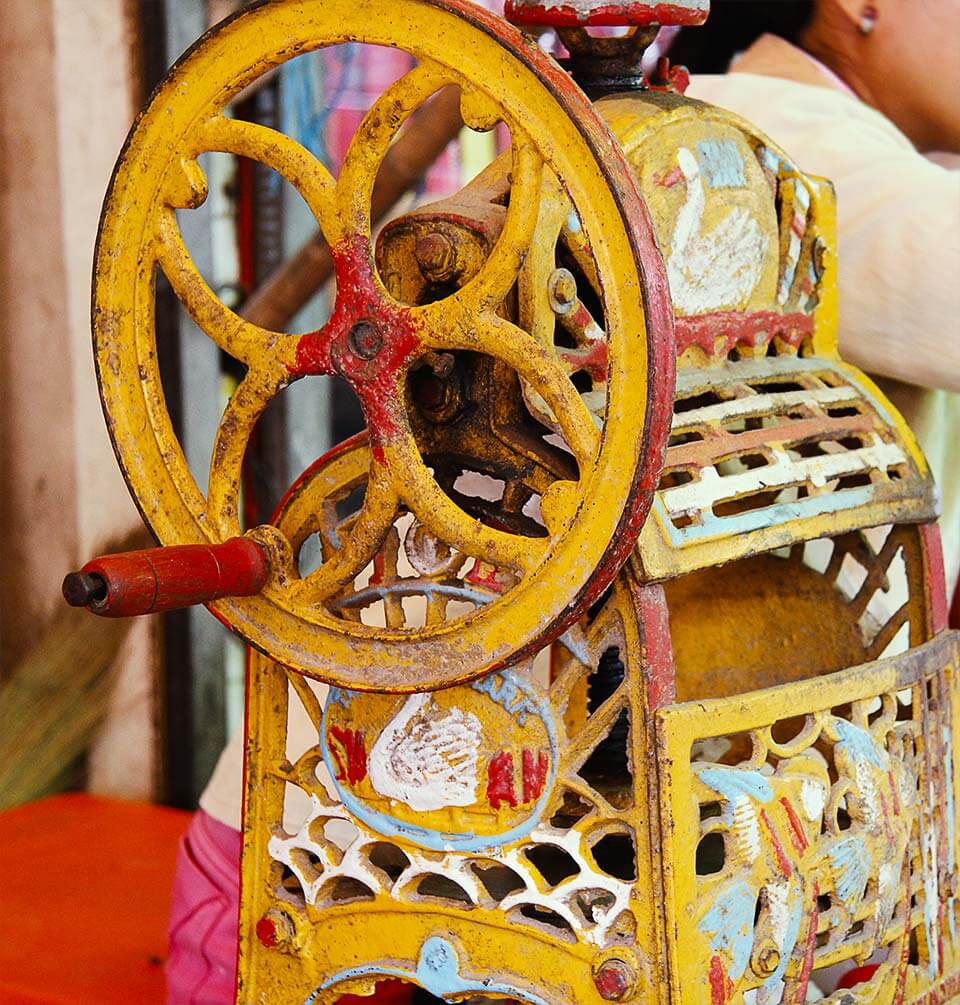
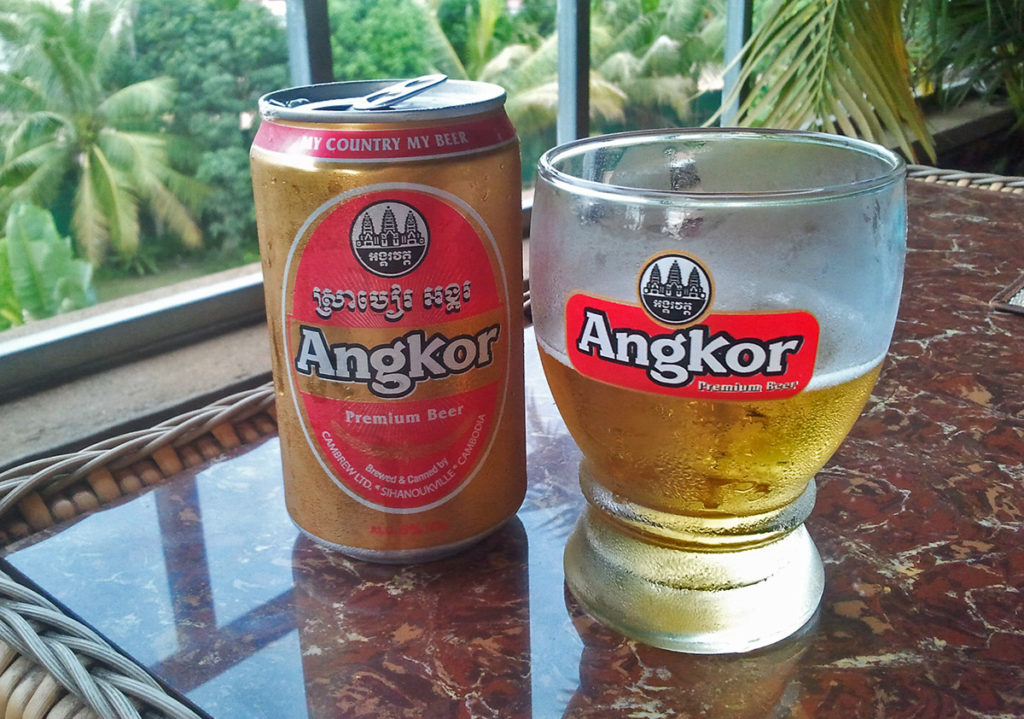
The first brewery in Cambodia was established in the 1930s. The best-known varieties today include Angkor Beer, Cambodia and Ganzberg, the latter a German Premium Beer. Rice wine is truly traditional. Made from cooked and dried rice and various herbs, it is sometimes also used as a medicine. If you want to know how distillation works and how the finished rice wine tastes: In Battambang, the aforementioned rice chamber, tour operators will show you the local factories.
Articles about Cambodian food & drink
Current articles about food and drink in Cambodia. More articles under the category “Food & Drink”.
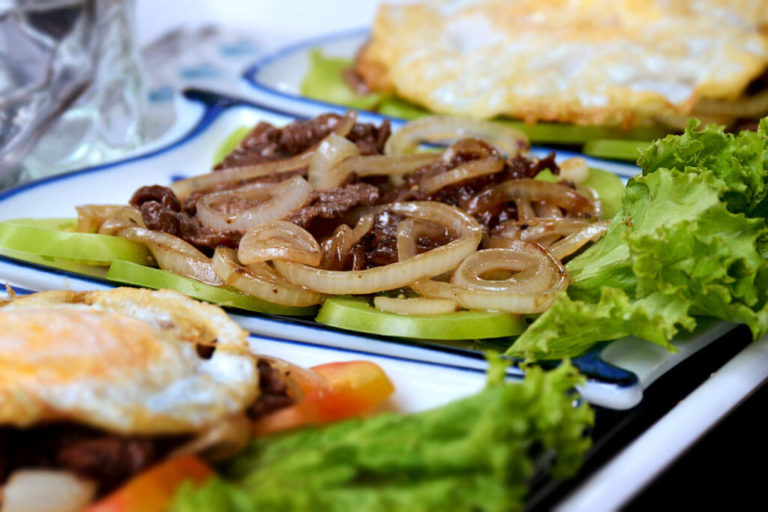
Beef Lok Lak – the Cambodian national dish. With recipe :-)
Indulge in the flavors of savory Beef Lok Lak, a must-try dish from Cambodia. Learn how to cook this recipe at home and satisfy your taste buds.
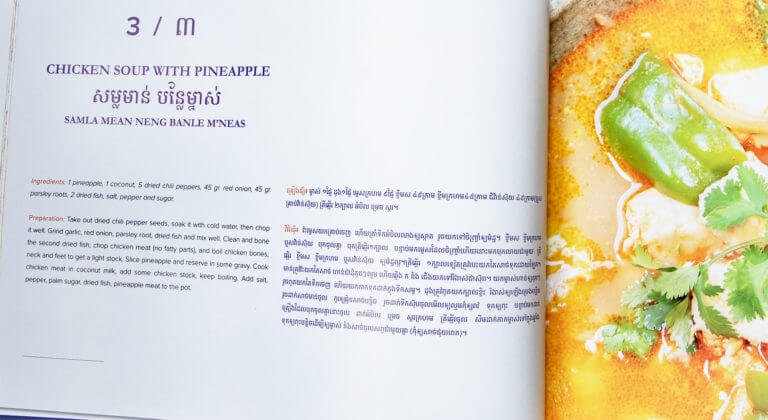
The Culinary Art of Cambodia {book presentation}
With “The Culinary Art of Cambodia”, we introduce you to a cookbook with Cambodian recipes in this article. Really? Another new cookbook? There are already plenty … Well, this book is more than just a cookbook. Because it is more than that. For us, it is a compendium of Cambodian cuisine. A gem that we…
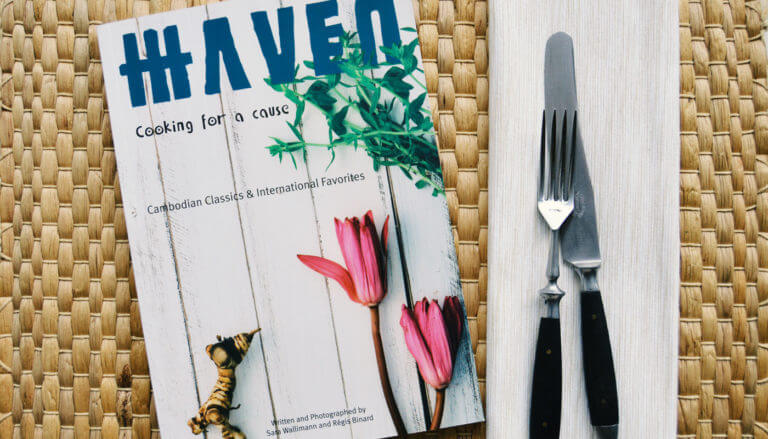
Heavenly – The Haven cookbook with recipes from the Cambodian Cuisine
Homage to the cookbook from the Haven restaurant with its fantastic recipes from the Khmer cuisine. **With Khmer Curry recipe**

Affiliate*
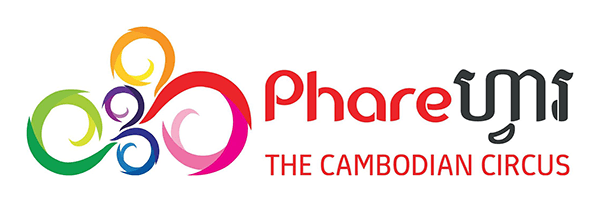
Phare, the Cambodian Circus
A highlight in Siem Reap! Buy tickets online directly on the Circus Phare website*.
Links and references with a * are an affiliate link (advertising link). If you like Visit Angkor and buy, book or subscribe to something via an affiliate link, the provider will make a small commission for Visit Angkor. Of course, there are no additional costs for you.
Join our Facebook group
International travel group with friendly people who love Cambodia. We speak English, German and a little Khmer.
By the way: We write here at Visit Angkor with a lot of passion and love. Nevertheless, it can happen that information is no longer up to date or perhaps even incorrect. We would be happy to hear from you so that we can update the information accordingly. Thank you very much!



